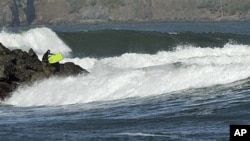Widespread tsunami warnings were issued Friday, after an earthquake off the coast of Japan unleashed waves that posed threats throughout the Pacific. One tsunami researcher said that while the tsunami warning system worked well, it remains difficult to make predictions about how damaging those waves might be.
A tsunami warning siren pierced the night in Hawaii and elsewhere in the Pacific Ocean Friday, after an 8.9 earthquake near the east coast of Honshu, Japan, generated tsunami waves, which move as fast as a jetliner.
The National Oceanic and Atmospheric Administration's Pacific Tsunami Warning Center issued a widespread warning from Japan to Peru.
Laura Furgione is the deputy assistant administrator at NOAA National Weather Service. She said warnings can remain in effect well after tsunami waves first hit a coastline because surges, currents and waves can pose problems for up to 12 hours. Furgione said NOAA updates its warnings using information gathered by 32 deep-ocean buoys that gauge sea levels in the Pacific.
"That information is put into our models, and we update the models and the advisories and warnings appropriately. So we were expecting some of the first waves into the Hawaiian islands around 8 a.m. and that's exactly what happened."
Phil Liu, a professor of Civil and Environmental Engineering at Cornell University in New York, said the early warning system worked well because the predicted arrival times were accurate. Liu helped to develop the tsunami coastal warning system for countries surrounding the Pacific Ocean.
"I firmly believe that the most important thing in the early warning system is to estimate the arrival time accurately so you can warn people to get away from the coast."
Liu noted that while scientists were able to accurately predict the waves' arrival, it is difficult to predict the potential size or destructiveness of tsunami waves.
"Usually when a tsunami propagates into the ocean, the wave amplitude or the size of the wave is not all that big - a meter or two at most. However, when these waves propagate into shallow water, they tend to become bigger. Exactly how big these waves will become really depends on the local bathymetry, how water depths vary, and also the configuration or orientation of the shoreline also plays an important role in determining exactly how big the wave might end up," said Liu.
Researchers explain that that earthquake off the coast of Japan resulted from a thrust event between the Pacific tectonic plate and an extension of the North American tectonic plate.
Senior science advisor for earthquakes and geologic hazards at the U.S. Geological Survey, Dave Applegate, said, "In the case of an undersea earthquake like this, you're transmitting energy not only through the crust, which is the strong shaking that is damaging to people and buildings, but you're also transmitting a lot of that energy into the water, and of course that represents the other part of this disaster which is the tsunami."
Applegate said aftershocks can continue for days, months and even years. Liu said while aftershocks usually do not spawn tsunamis, there are no guarantees.
And while Japan is one of the most seismically active places on Earth, Applegate said an earthquake of this magnitude is rare, even for the so-called "Ring of Fire."
"The only evidence we have is from monastic records going back to A.D. 869 - 1,200 years ago - of an earthquake of this magnitude rupturing along the plate boundary."
While experts have to delve into history to find an earthquake of this scope near Japan, lessons learned in recent history may have helped reduce the scale of this disaster. Tsunami researcher Liu said the public is more informed about the dangers of tsunamis, and warning systems were improved, after the devastating tsunami in the Indian Ocean in 2004.









